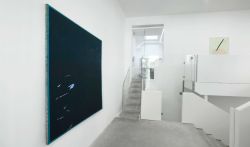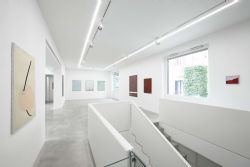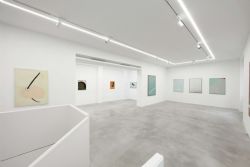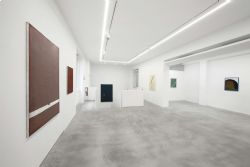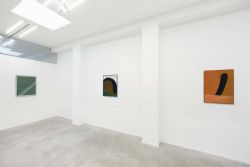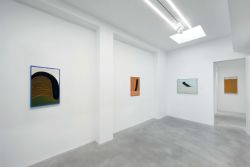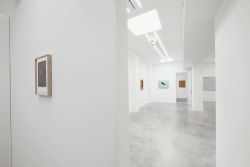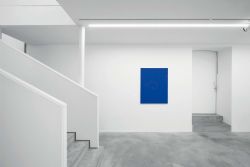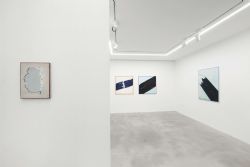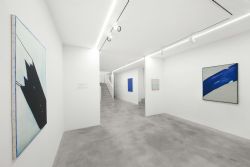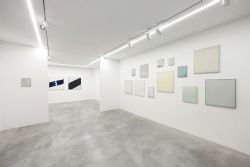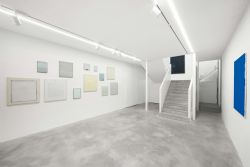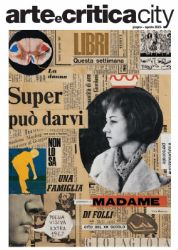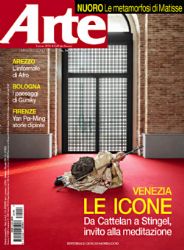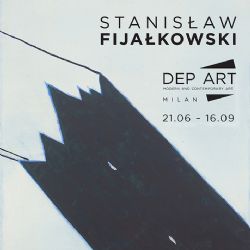
Dep Art Gallery presenta a Milano,
dal 21 giugno al 16 settembre 2023
la prima personale dell’artista polacco Stanisław Fijałkowski (1922-2020).
La mostra "Stanisław Fijałkowski", curata da Alberto Zanchetta, segna il ritorno dell’artista in Italia dopo la partecipazione alla XXXVI Biennale d’Arte di Venezia nel 1972. Una selezione di 27 opere che avvicina il pubblico italiano all’evoluzione pittorica di Fijałkowski, da cui emerge la predilezione dell’artista per una astrazione che risente dell’esperienza pittorica mitteleuropea e di uno approccio emotivo al colore.
Maestro della pittura astratta, le sue composizioni giocano con forme minimaliste e colore. Tutte le opere sono caratterizzate da ampie campiture, che spaziano dai colori delicati dei primi anni alle sfumature più cupe dell’ultimo periodo, e che spesso fanno da sfondo a segni grafici e forme riconducibili a elementi geometrici.
Nel corso degli anni Sessanta, la matericità e l’esuberanza cromatica si attenuano per lasciare posto a una pittura pura. Sulle tele ricorrono forme circolari, coni, nastri oppure linee che dagli anni Settanta evolveranno nelle famose Autostrade, che tendono verso l’alto, tracciando un percorso di elevazione. Per mezzo del processo pittorico, l'artista si liberava da ogni catena vincolante al mondo esteriore, cercando così di raggiungere il trascendente e aprendo una via verso la comunicazione con il divino.
L'ascesa verso la libertà, predetta da Fijałkowski, è strettamente legata all'interiorità e alla vita spirituale. In un mondo moderno sempre più privo di sacralità, la rinuncia al materialismo diventa una fonte di speranza e salvezza. Come sosteneva il pittore russo Wassily Kandinsky, il colore e l'astrazione offrono un accesso privilegiato all'anima, permettendo di risvegliarla e farla vibrare. Le opere di Fijałkowski, sebbene distanti dall'arte tradizionale, non possono essere incasellate nella sola categoria dell'astrazione: l'artista s'immergeva completamente nel processo pittorico, usandolo come mezzo per estraniarsi dal tempo e dallo spazio, cercando di superare i limiti della bidimensionalità e circoscrivendo il quadro come un rito fondativo, preservando i propri segreti.
Come scrive il curatore Alberto Zanchetta: “La principale preoccupazione dell’artista non consisteva nel creare qualcosa di nuovo ma di autentico. Privando l’arte di orpelli narcisistici e di elucubrazioni intellettuali, Fijałkowski si immedesimava nel proprio medium espressivo: la pittura fluiva spontaneamente, guidata da un rapimento estatico”.
Dai dipinti giovanili influenzati dal post-cubismo e dai Fauves, alle opere mature che esplorano la pura pittura e l'ascesa spirituale dell'individuo, il percorso artistico di Fijałkowski si manifesta in tutta la sua maturità: attraverso la riduzione ai minimi termini di segni e colori, l’artista enfatizza l'intensità emotiva delle sue opere. Ogni quadro è un'entità singolare e rappresenta l'espressione autentica di un'avventura legata a un'intensa e irripetibile condizione mentale-emotiva.
La mostra è accompagnata da un catalogo bilingue, italiano e inglese, che contiene il testo del curatore Alberto Zanchetta, la biografia aggiornata dell’autore oltre ad alcune foto storiche, le installation view delle sale della galleria oltre alla riproduzione fotografica di tutte le opere esposte.
La mostra è stata realizzata col patrocinio del Consolato Generale della Repubblica di Polonia in Milano.
Stanisław Fijałkowski (Zdołbunów 1922 - Łódź 2020) è stato allievo di Władysław Strzemiński e Stefan Wegner all'Accademia delle Arti di Łódź, in Polonia, dove diventerà a sua volta professore. Tra gli artisti polacchi più riconosciuti, le sue opere fanno parte delle maggiori collezioni di musei e gallerie del mondo, tra cui la Tate di Londra, il Museum of Modern Art di New York e il Pushkin Museum di Mosca.
Dep Art Gallery presents
the solo exhibition of Polish artist Stanisław Fijałkowski (1922-2020)
in Milan from June 21 to September 16, 2023.
The exhibition "Stanisław Fijałkowski," curated by Alberto Zanchetta, marks the artist's return to Italy after his participation in the XXXVI Venice Art Biennale in 1972. A selection of 27 works brings the Italian public closer to Fijałkowski's pictorial evolution, from which emerges the artist's predilection for an abstraction that is influenced by the Central European painting experience and an emotional approach to color.
A master of abstract painting, his compositions play with minimalist forms and color. All of the works are characterized by broad backgrounds, ranging from the delicate colors of his early years to the darker hues of his later period and often providing a backdrop for graphic signs and forms traceable to geometric elements.
During the 1960s, materiality and chromatic exuberance diminished to make way for pure painting. Circular shapes, cones, ribbons, or lines recur on the canvases, which, from the 1970s, will evolve into the famous Highways, which tend upward, tracing a path of elevation. Through the pictorial process, the artist freed himself from all chains binding him to the external world, thus seeking to reach the transcendent and opening a path to communication with the divine.
The ascent to freedom, foretold by Fijałkowski, is closely linked to interiority and spiritual life. In a modern world increasingly devoid of sacredness, the renunciation of materialism becomes a source of hope and salvation. As Russian painter Wassily Kandinsky argued, color and abstraction offer privileged access to the soul, allowing it to awaken and vibrate. Fijałkowski's works, although distant from traditional art, cannot be pigeonholed into the single category of abstraction; the artist immersed himself completely in the painting process, using it as a means of estranging himself from time and space, seeking to overcome the limits of two-dimensionality and circumscribing the painting as a foundational rite, preserving its secrets.
As curator Alberto Zanchetta writes, "The artist's main concern was not to create something new but something authentic. Depriving art of narcissistic trappings and intellectual elucubrations, Fijałkowski immersed himself in his expressive medium: painting flowed spontaneously, guided by ecstatic rapture."
From the youthful paintings influenced by post-Cubism and the Fauves to the mature works that explore pure painting and the spiritual ascent of the individual, Fijałkowski's artistic journey is manifested in all its maturity; through the reduction of signs and colors to the bare minimum, the artist emphasizes the emotional intensity of his works. Each painting is a singular entity and represents the authentic expression of an adventure linked to an intense and unrepeatable mental-emotional condition.
The exhibition is accompanied by a bilingual catalog, Italian and English, which contains the text by curator Alberto Zanchetta, an updated biography of the author as well as some historical photos, installation views of the gallery rooms, and photographic reproductions of all the works on display.
The exhibition was organized under the patronage of the Consulate General of the Republic of Poland in Milan.
Stanisław Fijałkowski (Zdołbunów 1922 - Łódź 2020) was a pupil of Władysław Strzemiński and Stefan Wegner at the Academy of Arts in Łódź, Poland, where he would, in turn, become a professor. Among the most recognized Polish artists, his works are part of major museum and gallery collections around the world, including the Tate in London, the Museum of Modern Art in New York, and the Pushkin Museum in Moscow.
